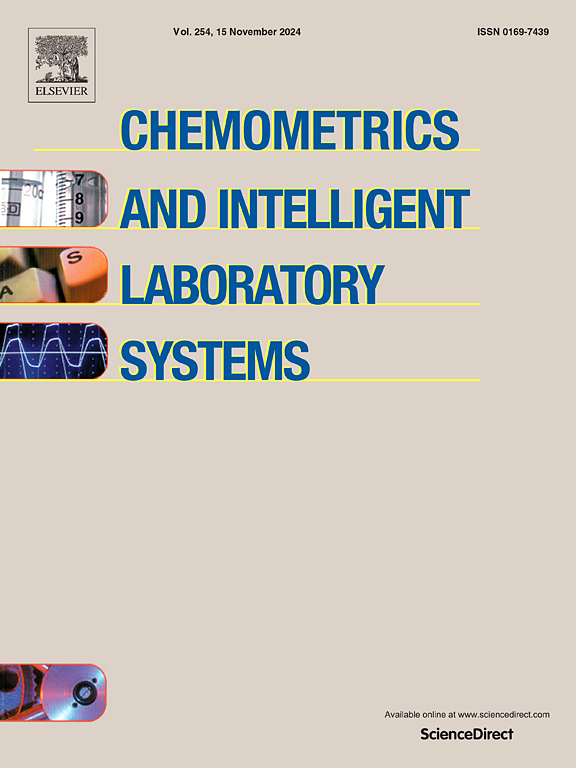评估没有测试数据集的稳健预测模型:近红外光谱的因果发现方法
IF 3.7
2区 化学
Q2 AUTOMATION & CONTROL SYSTEMS
Chemometrics and Intelligent Laboratory Systems
Pub Date : 2024-12-21
DOI:10.1016/j.chemolab.2024.105313
引用次数: 0
摘要
用光谱数据校准的机器学习预测模型使用变量之间的相关性而不考虑因果关系。缺乏真正的因果关系妨碍了确保系统预测可重复性的能力。因此,支持基于因果关系的发现的工具在光谱学和化学计量学中是必不可少的,以增强鲁棒性。因此,本研究运用因果推理理论建立因果发现指数(CDI),以区分具有可靠因果结构的数据集与容易产生虚假关联的数据集。将该框架应用于七个模拟的近红外光谱因果结构。利用模拟近红外光谱,确保框架性能在广义方法中得到优化和适当验证。通过自举CDI指数的均值和标准差的差异,证实了可靠结构的区分。在1000和10000的样本量上建立了不同的均值和标准差阈值。该框架在求导、降维等多种光谱预处理方法下均表现良好。它在变化中也具有鲁棒性,超越了传统的测试集验证方法,而无需使用额外的独立数据集。这将有利于新框架在数据集收集有限的实际情况下的适用性。此外,它可以扩展到各种基于传感器的数据,仅包含七种可能的因果结构。本文章由计算机程序翻译,如有差异,请以英文原文为准。

Assessing robust prediction models without test datasets: A causal discovery approach on near-infrared spectra
Machine learning prediction models calibrated with spectral data use correlations between variables without considering causation. The absence of genuine cause–effect relations hinders the ability to ensure methodical prediction reproducibility. Therefore, tools supporting causal-based discovery are essential in spectroscopy and chemometrics to enhance robustness. Accordingly, this study invokes causal inference theory to establish the causal discovery index (CDI) to distinguish datasets with reliable causal structures from those prone to spurious correlations. This framework was applied to seven simulated near-infrared spectral causal structures. Simulated near-infrared spectra were utilized to ensure that the framework performance was optimized and verified appropriately in a generalized methodology. Reliable structures were confirmed to be differentiated by the differences in the mean and standard deviation of bootstrapped CDI indices. Distinctive thresholds for the mean and standard deviation were established at the sample size of 1000 and 10,000. The framework consistently performed well with multiple spectral preprocessing methods such as derivation and dimension reduction. It was also robust with variations, surpassing the conventional test-set validation method without the use of additional independent datasets. This would benefit the applicability of the novel framework in practical situations where dataset collection can be limited. Moreover, it can be extended to various sensor-based data, encompassing only seven possible causal structures.
求助全文
通过发布文献求助,成功后即可免费获取论文全文。
去求助
来源期刊
CiteScore
7.50
自引率
7.70%
发文量
169
审稿时长
3.4 months
期刊介绍:
Chemometrics and Intelligent Laboratory Systems publishes original research papers, short communications, reviews, tutorials and Original Software Publications reporting on development of novel statistical, mathematical, or computer techniques in Chemistry and related disciplines.
Chemometrics is the chemical discipline that uses mathematical and statistical methods to design or select optimal procedures and experiments, and to provide maximum chemical information by analysing chemical data.
The journal deals with the following topics:
1) Development of new statistical, mathematical and chemometrical methods for Chemistry and related fields (Environmental Chemistry, Biochemistry, Toxicology, System Biology, -Omics, etc.)
2) Novel applications of chemometrics to all branches of Chemistry and related fields (typical domains of interest are: process data analysis, experimental design, data mining, signal processing, supervised modelling, decision making, robust statistics, mixture analysis, multivariate calibration etc.) Routine applications of established chemometrical techniques will not be considered.
3) Development of new software that provides novel tools or truly advances the use of chemometrical methods.
4) Well characterized data sets to test performance for the new methods and software.
The journal complies with International Committee of Medical Journal Editors'' Uniform requirements for manuscripts.

 求助内容:
求助内容: 应助结果提醒方式:
应助结果提醒方式:


